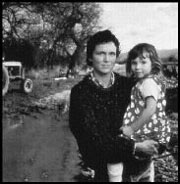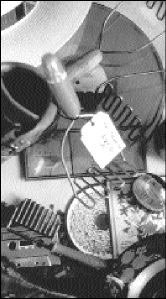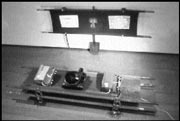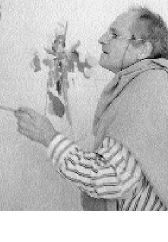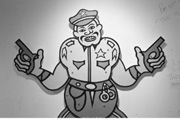ANNIE LEIBOVITZ: WOMEN
Seattle Art Museum, 100 University, 654-3100, $10 Sept. 20, 2001-Jan. 6, 2002
ANNIE LEIBOVITZ is a celebrity who photographs celebrities. While raising her to unprecedented star status in her own right, her distinctive, elaborately staged portraits of glitterati have redefined the possibilities of the celebrity photo and also shaped contemporary magazine photography as we know it. In the 1980s she worked hard to deconstruct the notion of photography as a pure conveyor of reality, setting up exaggerated studio shots (remember Whoopi Goldberg’s face peeping out from a milk-filled bathtub?) that pointedly revealed photography as a construction. Her trademark clarity, boldness, and simplicity make her Vanity Fair covers and Vogue fashion spreads immediately recognizable.
A couple years back, esteemed writer, feminist, and human rights activist Susan Sontag suggested that Leibovitz make a book of photographs of all kinds of American gals, women from every walk of life. The idea was to take a snapshot, if you will, of women at the turn of the millennium. Leibovitz, at first hesitant to take on a project so different from her usual work, eventually agreed and began making photographs that were unlike any she’d taken before. She went on field trips across America, seeking to photograph the diversity of the female landscape. In addition to contributing the introductory essay, Sontag helped choose many of the subjects for Women, the luxuriously produced book that came out in ’99. The same year, in what could be considered a brilliant promotional coup by the publisher, the Corcoran Gallery of Art in Washington, D.C., organized an exhibition of a selection of pictures from the book. And here it is in Seattle.
Grudgingly, I must admit that the exhibition manages to transcend its coffee-table book roots. The photographs are powerful in their aggressive scale (some are as big as 6 by 8 feet) and by their overwhelming numbers (there are over 70 in the show). As Sontag concedes in her essay, nobody scrutinizing these photographs will fail to note that plenty of gender stereotypes are confirmed. But in some cases they are challenged. More importantly, the ensemble forces a re-examination of how we look at images of women, the assumptions we make, and the conclusions we draw.
The portraits in Women include soldiers, astronauts, miners, athletes, artists, poets, executives, politicians, scientists, farmers, and, yes, a smattering of undeniably gorgeous movie stars. And while it’s practically impossible to disassociate Leibovitz from her glossy magazine spreads of glamorous celebs, the images in Women—even the stars—are less polished, as Seattle Art Museum curator Tara Young puts it, “less Hollywood.” Additionally, the photographs themselves are not glossy, and none are displayed behind glass. Celebrities, punk rockers, hookers, cheerleaders, and debutantes alike are thrown together willy-nilly, and with women from all walks of life interspersed this way, the playing field is leveled. Glamour pusses look more like normal everyday people, and regular folks gain stature.
This is no easy feat. Admit it, we’re a catty nation. Our years of fashion magazine training ensure that we automatically assess the attractiveness of the women in these photographs, passing judgment based on our culture’s narrow standards of beauty. Leibovitz capably manipulates our responses and, like magic, bestows upon wrinkles, diminutive postures, badass indignation, and even intellect the significance granted to physical beauty. For this project, she has sought out unconventional beauty—beauty in strength, in age, in grace, in clout, in innocence, in intelligence, in oddity—and she has a knack for presenting ugliness as boldly and beautifully as glamour.
Though she steps away from her staged studio sessions and in many cases shoots women in their natural habitats—Martha Stewart leans on her pickup truck, Hillary Clinton toils in her home office, Courtney Love is photographed ࠬa Marilyn in a bathrobe, lounging seductively in a lawn chair at her California home—the portraits are nonetheless undeniably choreographed, even in their presentation. A striking example of this is a dry, black-and-white image of a plain woman next to a color portrait of the same woman in full Vegas showgirl regalia: fishnet stockings, headdress, a gold cape, bare breasts. With this clever juxtaposition, Leibovitz not only reveals the power of the photographer to steer the viewer’s reaction, but also the theater production that is gender and, as with the rest of the show, forces us to confront our own manner of looking and our own notions of beauty and sexuality.
